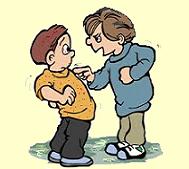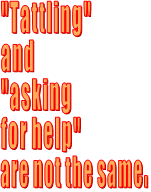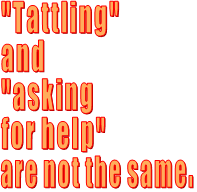
Bullying: In Schools


Bullying: In the Schools

www.EducationDx.com

Other pages of interest:

EducationDx
©2015, 2023
©2015, 2023


■
What is Bullying?
■
Bullying Quick Notes
■
Dealing with Bullying
■
Cyberbullying
■
Bystander Intervention
What is bullying?
"A person is bullied when he or she is exposed, repeatedly and over time, to negative actions on the part of one or more other persons, and he or she has difficulty defending himself or herself," according to Dan Olweus, creator of the Olweus Bullying Prevention Program . Other bully prevention programs have similar definitions. Bullying can be verbal, physical, social or even over the phone or computer (cyberbullying).
"A person is bullied when he or she is exposed, repeatedly and over time, to negative actions on the part of one or more other persons, and he or she has difficulty defending himself or herself," according to Dan Olweus, creator of the Olweus Bullying Prevention Program . Other bully prevention programs have similar definitions. Bullying can be verbal, physical, social or even over the phone or computer (cyberbullying).


Some schools have anti-bullying policies in place, but do not have a prevention/intervention program. Bullying, in the absence of a program, is sometimes treated as a violation of the discipline code. Unfortunately, the line becomes blurry between a victim and the bully, and punishment is handed out without regards to future prevention or rehabilitation efforts.
Rules:
1-No Bullying
2-3 day suspension
3-It's not nice to bully--Don't get caught
1-No Bullying
2-3 day suspension
3-It's not nice to bully--Don't get caught
What can educators, parents, and students do about all forms of bullying?
The answer is to encourage all members of the school community (this includes educators, students, parents, community members, others) to adopt a bully prevention/intervention philosophy. Then have the school board formalize the philosophy into a program, and then into practice.

Bullying Quick Notes
*Most bully prevention/intervention programs have some common themes. A bully prevention/intervention program should start with a bullying survey or assessment to determine the extent of the problem.
*Researchers have not been able to find a link between bullies and any particular religion, race, income level, divorce, or any other socio-economic factor.
*Girls are just as likely as boys to bully and abuse others verbally, although boys are three times more likely to be physically abusive.
*While many bullies are themselves bullied at home or at school, new research shows that most bullies actually have excellent self-esteem.
*Don't rely on conflict resolution and peer mediation strategies for reducing bullying, since researchers have found these tactics to be ineffective.
*Bullying is not a conflict--but rather a form of victimization.
*In order to effectively accomplish its goals of reducing existing bullying problems and preventing the development of future problems, you must go through a series of tasks that make you aware of the extent of the bullying problem and help solve it.
*Parents are very important for the success of the bully prevention program and should be involved in all levels of the program.
*In the classroom portion of the bullying prevention/intervention program, there should be immediate consequences for aggressive behavior and immediate rewards for inclusive behavior.
*An effective program includes looking for ways that community members can support the school's efforts.
*Sometimes children that are being bullied often stand out as different in some way because of appearance, sexual orientation, intellect, socio-economic background, cultural or religious background, or just being "different."
*Research suggests that there are two categories of bullied children: (1) passive victims and (2) provocative victims or bully/victims.
*One effect of being bullied is lower self-esteem.
*Some bystanders are too afraid to get involved.
*Adults should: stop the bullying, support the child being bullied, name the bullying behavior, refer to the rules against bullying, impose immediate and appropriate consequences, and empower children witnessing the bullying.
*Program goals should include changing the norms around bullying behavior and restructuring the school setting itself so that bullying is less likely to occur or be rewarded.
*A school should have a comprehensive bully prevention/intervention program.
*When adults are present to supervise a particular setting, intervene quickly when they witness bullying behavior, and provide fair and appropriate consequences to the bully for his or her misbehavior, the rate of bullying in that setting will plummet.
*Parents should make teachers and other caregivers aware of a bullying problem and work together to address it.
*Successful programs have ongoing meetings between parents and school staff.
*Cyberbullying is sending messages, pictures, or information using electronic media, computers or cell phones.
*Not wanting to go to school could be a sign a child is being bullied.
*Children that are bullied should walk away, tell an adult, talk it out, and hang out with friends.
*"Tattling" and "asking for help" are not the same.




EducationDx
is a
FREE
Website
is a
FREE
Website

Why are some children afraid to go to school?
Why do some children hate to go to school?
Why do some children hate to go to school?





www.EducationDx.com
This is a FREE information site!
Note: Larger computer screens will show larger materials!
Bullying in the Schools
What is bullying?
"A person is bullied when he or she is exposed, repeatedly and over time, to negative actions on the part of one or more other persons, and he or she has difficulty defending himself or herself," according to Dan Olweus, creator of the Olweus Bullying Prevention Program . Other bully prevention programs have similar definitions. Bullying can be verbal, physical, social or even over the phone or computer (cyberbullying).
"A person is bullied when he or she is exposed, repeatedly and over time, to negative actions on the part of one or more other persons, and he or she has difficulty defending himself or herself," according to Dan Olweus, creator of the Olweus Bullying Prevention Program . Other bully prevention programs have similar definitions. Bullying can be verbal, physical, social or even over the phone or computer (cyberbullying).
Bullying: In Schools


Some schools have anti-bullying policies in place, but do not have a prevention/intervention program. Bullying, in the absence of a program, is sometimes treated as a violation of the discipline code. Unfortunately, the line becomes blurry between a victim and the bully, and punishment is handed out without regards to future prevention or rehabilitation efforts.
What can educators, parents, and students do about all forms of bullying?
The answer is to encourage all members of the school community (this includes educators, students, parents, community members, others) to adopt a bully prevention/intervention philosophy. Then have the school board formalize the philosophy into a program, and then into practice.
Rules:
1-No Bullying
2-3 day suspension
3-It's not nice to bully--Don't get caught
1-No Bullying
2-3 day suspension
3-It's not nice to bully--Don't get caught

Why are some children afraid to go to school?
Why do some children hate to go to school?
Why do some children hate to go to school?
*Most bully prevention/intervention programs have some common themes. A bully prevention/intervention program should start with a bullying survey or assessment to determine the extent of the problem.
*Researchers have not been able to find a link between bullies and any particular religion, race, income level, divorce, or any other socio-economic factor.
*Girls are just as likely as boys to bully and abuse others verbally, although boys are three times more likely to be physically abusive.
*While many bullies are themselves bullied at home or at school, new research shows that most bullies actually have excellent self-esteem.
*Don't rely on conflict resolution and peer mediation strategies for reducing bullying, since researchers have found these tactics to be ineffective.
*Bullying is not a conflict--but rather a form of victimization.
*In order to effectively accomplish its goals of reducing existing bullying problems and preventing the development of future problems, you must go through a series of tasks that make you aware of the extent of the bullying problem and help solve it.
*Parents are very important for the success of the bully prevention program and should be involved in all levels of the program.
*In the classroom portion of the bullying prevention/intervention program, there should be immediate consequences for aggressive behavior and immediate rewards for inclusive behavior.
*An effective program includes looking for ways that community members can support the school's efforts.
*Sometimes children that are being bullied often stand out as different in some way because of appearance, sexual orientation, intellect, socio-economic background, cultural or religious background, or just being "different."
*Research suggests that there are two categories of bullied children: (1) passive victims and (2) provocative victims or bully/victims.
*One effect of being bullied is lower self-esteem.
*Some bystanders are too afraid to get involved.
*Adults should: stop the bullying, support the child being bullied, name the bullying behavior, refer to the rules against bullying, impose immediate and appropriate consequences, and empower children witnessing the bullying.
*Program goals should include changing the norms around bullying behavior and restructuring the school setting itself so that bullying is less likely to occur or be rewarded.
*A school should have a comprehensive bully prevention/intervention program.
*When adults are present to supervise a particular setting, intervene quickly when they witness bullying behavior, and provide fair and appropriate consequences to the bully for his or her misbehavior, the rate of bullying in that setting will plummet.
*Parents should make teachers and other caregivers aware of a bullying problem and work together to address it.
*Successful programs have ongoing meetings between parents and school staff.
*Cyberbullying is sending messages, pictures, or information using electronic media, computers or cell phones.
*Not wanting to go to school could be a sign a child is being bullied.
*Children that are bullied should walk away, tell an adult, talk it out, and hang out with friends.
*"Tattling" and "asking for help" are not the same.


Bullying Quick Notes




Next>>
Dealing with Bullies
Dealing with Bullies
EducationDx
©2015, 2023
©2015, 2023

Some educators may underestimate the extent and effect of bullying in their schools. Some children see bullying as the worst problem in their lives. The significance level may range from anger/frustration to self-harm or harm to others. Some of the statistics on school bullying are not current, are sometimes ambiguous and vary by source.
Some educators may underestimate the extent and effect of bullying in their schools. Some children see bullying as the worst problem in their lives. The significance level may range from anger/frustration to self-harm or harm to others. Some of the statistics on school bullying are not current, are sometimes ambiguous and vary by source.

Amazon Links


Disclosure:
Some links on this website are associate links and are used to help illustrate what an item looks like, and you can decide if you want to just look or purchase the item. "As an Amazon Associate, I earn from qualifying purchases." We receive a small commission (that helps support this website) if you actually purchase from this company, but the price to you remains the same.
You can hover over any link to see if it is an Amazon link, if this matters, or a link to a page on this website or to a reference page, e.g., Smithsonian Institution, bookmark on this website, etc.
Some links on this website are associate links and are used to help illustrate what an item looks like, and you can decide if you want to just look or purchase the item. "As an Amazon Associate, I earn from qualifying purchases." We receive a small commission (that helps support this website) if you actually purchase from this company, but the price to you remains the same.
You can hover over any link to see if it is an Amazon link, if this matters, or a link to a page on this website or to a reference page, e.g., Smithsonian Institution, bookmark on this website, etc.


Amazon Links
Disclosure:
Some links on this website are associate links and are used to help illustrate what an item looks like, and you can decide if you want to just look or purchase the item. "As an Amazon Associate, I earn from qualifying purchases." We receive a small commission (that helps support this website) if you actually purchase from this company, but the price to you remains the same.
You can hover over any link to see if it is an Amazon link, if this matters, or a link to a page on this website or to a reference page, e.g., Smithsonian Institution, bookmark on this website, etc.
Some links on this website are associate links and are used to help illustrate what an item looks like, and you can decide if you want to just look or purchase the item. "As an Amazon Associate, I earn from qualifying purchases." We receive a small commission (that helps support this website) if you actually purchase from this company, but the price to you remains the same.
You can hover over any link to see if it is an Amazon link, if this matters, or a link to a page on this website or to a reference page, e.g., Smithsonian Institution, bookmark on this website, etc.

Next>>
Dealing with Bullies
Dealing with Bullies